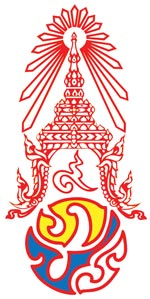
By Peter Cummins, Special Correspondent, Pattaya
Mail
Photos: Courtesy of the Bureau of the Royal Household
Prologue
It is very difficult to encapsulate the incredible achievements of our
beloved King in this short article. The writer, rather, has highlighted
just some of the events, honours and accolades which have been dedicated to
His Majesty, particularly in this auspicious year of his 81st birthday.

Born on Monday, the fifth of December, 1927 at the Mount Auburn Hospital,
Cambridge, Massachusetts, HM King Bhumibol Adulyadej the Great reaches his
eighty-first birthday just two years after celebrating sixty years on the
Thai Throne.
As the Thai people - and, in fact, people all around the world - honour this
year’s anniversary of the birth of the world’s longest-reigning Monarch, the
Pattaya Mail presents this supplement, prepared by special
correspondent Peter Cummins, as a “Happy Birthday” tribute to our beloved
King.
In his Coronation Oath, promulgated on the fifth of May 1950, the
newly-crowned King Rama the Ninth vowed that, “We will reign with
righteousness for the benefit and happiness of the Siamese people” and in
all the years which have passed since that auspicious day, the concept of
“righteousness” has dominated his reign. In fact, HM the King has,
throughout his more than six decades of rule, constantly revered the age-old
Buddhist concept of ‘Kingship’ as defined in the “Sutta Pitaka” of the
“Tripitaka” in which a King is defined as “Mahasammata” - a King of
Righteousness. The Buddhist scriptures also define the genesis of the
universe and the progression of evils which befall mankind: greed, stealing
and lying and the inevitable repercussions of censure and punishment.
Our King has steadfastly reigned by these principles, embodying good
kingship in his own life and example and often speaking out against the
affliction of the evils so clearly spelled out in the Buddhist philosophy -
evils and afflictions which seem to have become progressively worse in the
past tumultuous years.
There will inevitably be some familiar material in parts of this story, for
HM the King’s development projects have been ongoing for more than 50 years
and there is, of course, a historical perspective which has been
incorporated.

King Bhumibol Adulyadej’s
coronation, 5 May 1950
Accession to
the Thai Throne
His Majesty the King was pronounced successor to the throne in June 1946.
After four years of studying in Europe, he returned to Thailand and was
crowned during an elaborate and highly intricate ceremony.
On April 28, 1950, a week before his coronation, H.M. King Bhumibol and Mom
Rajawongse Sirikit Kitayakara were married. Following the coronation HM the
King returned to Switzerland to continue studying.
The Coronation Ceremony reinforces the stature of the Kings of Thailand. The
first such elaborate ceremony was performed when Pho Khun Phamuang succeeded
Pho Khun Bangklangthao as the ruling King of Muang Sukhothai. Phaya Lithai,
a former leader in Sukhothai, left a historical record in stone describing
the coronation ceremony in Sukhothai at Wat Srikhum.

In the beginning of the Ratanakosin era, the first King in the Chakri
Dynasty (King Buddha Yot Fa Chulalokmaharach) took the title of Rama I and
moved the capital of Siam from Thonburi to the opposite bank of the Chao
Phraya River, and constructed Krung Ratanakosin (Bangkok). In the process of
building the Royal Palace and Wat Prakaew (Temple of the Emerald Buddha),
the first King in the House of Chakri refined the coronation ceremony,
establishing important protocol that has lasted to this day.
The annual commemoration of the coronation ceremony is a three-day affair,
starting with a ritual “tham bun” ceremony on May 3 to honour the King’s
ancestors. Later on the first day, another ceremony is performed, whereby
flags of honour are issued to distinguish various military units.
The following day, Buddhist ceremonies continue with chanting rituals,
prayers and Brahman priests announce the auspicious occasion of the next day
(May 5).
On May 5, His Majesty King Bhumibol Adulyadej the Great (Rama IX) conducts a
merit-making ceremony, presenting offerings to Buddhist monks, and leads a
“Wien Thien” ceremony, walking three times around the sacred grounds at the
Temple of the Emerald Buddha.
In the evening HM the King conducts another sacred ceremony: changing the
yellow cloth on the Emerald Buddha, the guardian symbol protecting the Thai
people, which was transferred from Thonburi to Wat Phra Kaew by King Rama I.
Many rooms in the Royal Palace are opened for public viewing on Coronation
Day. Auspicious ceremonies are performed and displays depicting royal
achievements are exhibited to reconfirm the King’s stature.
King
Bhumibol Adulyadej: Ever Attentive to Royal Duties
His Majesty the King continued to have many official duties over the past
years, culminating in an abundance of official functions two years ago to
commemorate his Diamond Jubilee on the Thai Throne, continuing right through
to this year, up to his 81st birthday.
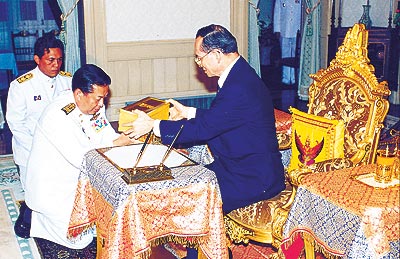
One of his many functions during this period was to open the new Rama VIII
Bridge - the 475-metre long cable-stay bridge which the King had planned
since July 1996, having it constructed to commemorate King Ananda Mahidol,
Rama the Eighth.
HM King Bhumibol introduced a number of aesthetic designs based upon the
former King’s royal seal. As in all of His ideas, the new bridge was
designed and built to have the least possible effect on the fragile
environment of the Chao Phraya River, the riverbanks and the surrounding
river approaches.
After the official opening, the City of Bangkok presented His Majesty with a
24K gold model of the bridge, and a gold plate with the bridge engraved upon
it to HRH Princess Maha Chakri Sirindhorn who accompanied HM the King at the
opening.
Development
Centres
Over the years, the King has established five Royal Development Study
Centres - or, as they are better known - “Living Museums” - situated in the
roughest terrain in their respective regions. These centres are the locale
for experiments in re-forestation, irrigation, land development and farm
technology which are conducted to find practical applications within the
constraints of local conditions, geography and topography. His Majesty’s aim
is to restore the natural balance, to enable people to become
self-supporting.
The first centre organized was that of Khao Hin Son, in the rocky area of
Chachoengsao’s Phanom Sarakam District. Here, the centre studies how to turn
the barren soil, caused by de-forestation, back into fertile land again.
Other centres are located at strategic places around the Kingdom. The Pikul
Thong Centre at Narathiwat studies the swampy, acidic land of the
southern-most region.
The Phu Phan Centre in Sakhon Nakhon studies soil salinization and
irrigation in the country’s biggest region, the Northeast which suffers from
endemic drought.
The Krung Kraben Bay Centre in Chantaburi examines the rehabilitation of
mangrove forests and coastal areas following massive destruction.
The Huay Sai Centre in Petchaburi studies the rehabilitation of degraded
forests and shows villagers, in their turn, how to protect the forests.
When he is in doubt, HM the King will fly over a particular area, armed with
aerial photographs and maps of the terrain, noting features as they pass
underneath. But, being a good photographer himself, he also takes his own
pictures and later juxtaposes them over the charts to obtain a detailed
image of the area of his concern which helps in his planning of specific
development projects.
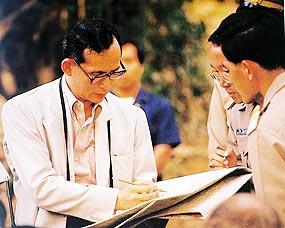
Throughout the more than six decades that HM the King has ruled Thailand,
not only Thais, but people around the world have become accustomed to seeing
His Majesty travelling to remote areas of the country. He works with - and
brings rational development to - even the poorest and most disadvantage
groups. He is often filmed leading officials, farmers and many diverse
groups up rough mountain trails, over bridges, punting along in small
sampans, to initiate sustainable projects and ideas, aimed at helping the
many who have been forgotten or left behind in the development process.
His Majesty’s insightful approach to local prevailing conditions has enabled
him to improvise new theories for agricultural development, to provide
guidelines for educating farmers on self-sufficiency, and to solve problems
of goitre by feeding iodine into salt roads at strategic points.
In all these works, His Majesty has promoted a simple approach using
environmentally-friendly techniques and utilizing moderate amounts of
locally available resources. For example, before environmentalism became a
major force in the development equation, His Majesty was using vetiver grass
to prevent erosion, controlling ground water level to reduce soil acidity,
and seeding clouds with simple materials such as dry ice to produce rain.

A ‘Simple’
Approach
HM the King’s philosophy to development problems has been to “keep it
simple”, relying on an intimate knowledge of Nature and her immutable laws,
such as using fresh water to flush out polluted water or dilute it through
utilization of normal tidal fluctuations. The ubiquitous water hyacinth,
too, can be ‘harnessed’ to absorb pollutants.
The results of any development, HM the King asserts, must reach the people
directly as a means of overcoming immediate problems, translating into
“enough to live, enough to eat”, while looking at a longer-term result of
“living well and eating well.”
His Majesty compares this to using “adharma” (evil) to fight evil, observing
that both pollution and the water weed are a menace, but they can be used to
counteract each other, thus lessening the damage to the environment.
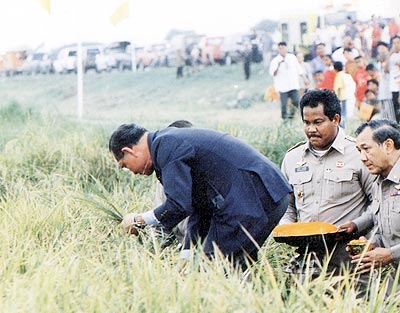
HM the King himself practices this “simple approach” and brings a
down-to-earth approach to which the people can readily relate. He studies
and deliberates exhaustively on the particular project and then reveals his
thinking in short, easy-to-grasp titles. The very simplicity belies the
profundity of the philosophy, for each title reflects a much deeper insight
into a given problem and often, at the same time, hints at the mode of
operation to be employed.
A major working principle has been a true knowledge of and reliance upon the
immutable laws of Nature in solving problems and resolving abnormal
conditions, such as using fresh water to flush out polluted water, as in his
analogy “good water chases bad”, referring to the hyacinth/water pollution
problem in the Chao Phraya, for example.
It was in 1969 that HM the King, vitally concerned about the Hill Tribes’
cultivation of and addiction to opium, established the Royal Project, the
first manifestation being a Hmong village on Doi Pui in Chiang Mai Province.
Development has now spread to Chiang Rai, Lamphun and Mae Hong Son.
Over the years, the Projects have been instrumental in the conversion of the
poppy fields being turned into groves of temperate fruits and vegetables. It
is under the dynamic direction of HM the King’s close colleague, friend and
confidant, Prince Bhisadej Rajanee who manages the projects from his base at
Chiang Mai University, that there are now five research stations and 35
Royal Project Development Centres which incorporate some 300 villages,
comprising 14,000 households and approximately 90,000 farmers.
The Royal Development Projects Board, under the Office of the Prime
Minister, also serves as the secretariat for the Chai Pattana Foundation
which is directly responsible for the work related to the Royal Development
Projects.
Thus, more than three decades later, the results can be seen in the new life
that has come to many of the mountain villages. Greenery has returned to
areas once denuded of forest cover through the highly-destructive
slash-and-burn agriculture, leaving only barren hills in its wake, and opium
cultivation, a cause of extreme national concern, is relegated to the
dust-bin of history.
“The key to the success of the Project lies in His Majesty’s guidelines,”
explains Prince Bhisadej. “They focus on obtaining knowledge, through
research, avoiding bureaucratic entanglements and swift action to respond to
the villagers’ needs, while promoting self-reliance,” he adds.
The effectiveness of this approach has been applauded internationally. For
example, in 1998 the Royal Project won both the “Magsaysay Award for
International Understanding” and the “Thai Expo Award for the Highest
Quality Standard of Thai Goods for Export.”
HM the King’s own views are that development must respect different regions’
geography and people’s way of life. “We cannot impose our ideas on the
people - only suggest. We must meet them, ascertain their needs and then
propose what can be done to meet their expectations,” HM the King pointed
out recently.
HM the King’s ideas are in direct contrast to the bureaucracy’s wish to
impose standards from the top down, with the inflexibility inherent therein.
“Don’t be glued to the textbook,” he admonishes developers “who”, he said,
“must compromise and come to terms with the natural and social environment
of the community.”
HM the King sees no need to spare any sensitivities - if there are any -
because he feels that the government approach is costly and authoritarian
which is why it has “failed miserably to address the country’s problems.”

HM the King’s
Philosophy
His Majesty the King has stated his opinion on countless matters over the
years. These royal words of wisdom reflect his great sensitivity to the
needs of his people and their problems and his down-to-earth approach to
problem-solving.
Herewith are some excerpts on His Majesty’s ideals:
I shall reign with righteousness for the happiness and benefit of the
Siamese people, was his promise 60 years ago.
To achieve desired results that are also beneficial and morally just, you
need more than just knowledge: You need honesty, sincerity, and justice.
Knowledge is like an engine that propels a vehicle. Moral principles are the
steering wheel or rudder that leads the vehicle safely in the right
direction.
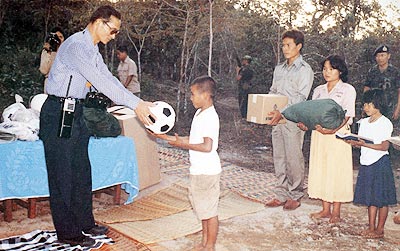
Knowledge helps you to understand religion on a broad basis; religion helps
you understand knowledge in depth. Therefore knowledge and religion have to
go hand-in-hand; they are both essential to life. Whoever possesses both
knowledge and religion shall achieve success in life without fail, because
they can analyse everything in detail and a rational way.
Academic subjects that you are constantly being tested for, do not alone
account for your survival and will not create benefit for yourself, for
others, or for the country. Those with knowledge also need other additional
qualifications to bring themselves and the nation to survival and
prosperity.
The necessary qualifications are a tender conscience, honesty in thought and
deed, loyalty to the nation and your patrons, selflessness and not taking
advantage of others, sincerity and meaning well to others, generosity as
benefiting your status and position, and most importantly, perseverance.
Practice doing projects on your own both big and small, simple and
complicated, with determination, without sloth, carelessness, or vulgarity.
When you want to study anything in depth, you have to study it from every
conceivable angle, not only in part, or become fixated on a particular
aspect. Secondly, what you must also do is consider the subject with an
unbiased and unwavering heart. Do not let the dark influence of prejudice
misguide you, whether it is prejudice in favour of, or against, the matter.
Otherwise, the knowledge which is gained will not be true knowledge, but
knowledge that is a mere illusion, or misleading. It cannot be applied to
create benefit without incurring negative results.
When you have clearly analysed the issue with a heart that is unbiased, then
only will true understanding arise, leading to a just decision and action.
You must set your mind to be objective, not allowing any prejudice to
prevail. Let your heart be led by truth and justice, based on reason and
morality.
Knowledge, intelligence, and efficient equipment, alone cannot help us
create total prosperity and stability for the country. To do so we need one
other element, that is unity, or cooperation, so that we can use that
knowledge, intellect and equipment to create true prosperity as desired.
Diamond
Jubilee for HM the King

His Majesty the King, center left,and Her
Majesty the Queen, center right, pose with the visiting representatives of
25 royal houses from Europe, Africa, the Middle East and Thailand’s Asian
neighbors in the elaborate century-old high ceillinged Ananda Samakhom
Throne Hall in Bangkok June 12, 2006. (AP PHOTO)
In 2006, on the occasion of the 60th anniversary
of his accession to the Thai Throne, HM the King and Queen presided over
splendid festivities as representatives of 25 royal houses from
Europe, Africa, the Middle East and Asia had come to Bangkok to honour His
Majesty King Bhumibol Adulyadej the Great.
The royal guests came from near and far to enjoy Thai hospitality and the
friendship of the Thai Royal Family.
But - and, perhaps, more significantly - to honour this celebration,
millions of people, sporting the “Royal Yellow” shirts (the official colour
of the King’s household) packed the areas around Bangkok’s Royal Plaza to
hear HM the King deliver a rare public address in which he called for
national unity.
“The responsibility to preserve the nation,” His Majesty reminded his
subjects, “does not belong to any particular person but to all Thais who
must do their utmost to develop the country and make it prosperous, stable
and peaceful,” he said. “Therefore, I, as a Thai, have the same
responsibility as all Thais do.”
A Sea of
Yellow
It was a schoolgirl whose handwritten declaration of love for the Monarch
who designed the shirt and wrote the text for many other products made
available to honour HM the King on his Diamond Jubilee.
Written in a childish hand, the slogan “Rao Rak Nai Luang” (We love the
King) is undoubtedly one of the most familiar sights across the nation
today. You see it everywhere, on T-shirts, bumper stickers, wristbands -
coffee mugs even.

Although it looks like the work of a small child, the short sentence that
has captured the hearts of so many Thais and foreigners alike, was actually
penned by secondary-school student Nop-abha “Yui” Devakula, about six years
ago - long before yellow-shirt fever descended on the Kingdom.
A smiling Nop-abha, now 23, a former student at Kasetsart University’s
Faculty of Humanities, recalls how it all started back in 2002.
Many thought that the various fonts used in a nation-wide competition did
not reveal the true Thai devotion to their King and, eventually, her
handwritten “Rao Rak Nai Luang” with a red heart encircling the word “rak”
was the one that was eventually picked from the bunch.
“I drew characters with a computer mouse, not a pen,” notes Nop-abha, a
granddaughter of Lord Chamberlain Keokhwan Vajarodaya and his wife,
Thanpuying Pensri. “It does have a child-like quality which I thought
appropriate to dedicate to the father of our country and of all the Thai
people,” concluded Nop-abha.
Accolades
Pour In
The King has been named an ‘Asian Hero’ among 65 prominent figures
designated by Time Magazine as “Asian Heroes”.
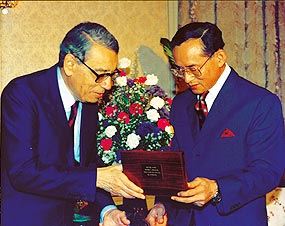
H.E. Boutros Boutros-Ghali presents a gift to
H.M. The King, Chitralada Palace, 10 Apri 1993
“The King’s stewardship has been so masterful that in times of crisis, Thais
invariably turn to one man: (HM) King Bhumibol,” writes the article
published in the magazine’s Nov 13, 2006 issue.
“On two occasions - October 1973 and May 1992 - with Thailand descending
into chaos, (HM) the King, armed only with his moral authority, intervened
to end blood-shed,” it said.
Elsewhere, His Majesty has been named the first recipient of the Norman E
Borlaug World Food Prize Medallion in recognition of His Majesty’s
outstanding humanitarian service in alleviating starvation and poverty,
presented by the World Food Prize Foundation on July 23, 2007.
The award, introduced for the first time last year as a special
commemoration of the World Food Prize’s 21st anniversary,
is a special honour for individuals who have provided exceptional
humanitarian service in reducing hunger and poverty.

HM King Bhumibol Adulyadej shakes hands with The
United Nations Secretary General Kofi Annan at Klai Kangwol Palace in
Prachuab Khiri Khan province, May 26, 2006. Annan presented a human
development lifetime achievement award to His Majesty as the country
celebrated the 60th anniversary of His accession to the throne. Looking on
is HRH Princess Maha Chakri Sirindhorn. (AP PHOTO)
The medallion is named in honour of the World Food Prize founder and Nobel
Peace Prize Laureate Dr Norman Borlaug.
“Since his accession to the throne in 1946, (HM) King Bhumibol Adulyadej has
displayed a deep concern that the Thai people have sufficient food and
proper nutrition,” said Ambassador Kenneth M Quinn, president of the World
Food Prize Foundation.
“His Majesty’s commitment to his subjects has been reflected in the more
than 2,000 royal projects he has established throughout the country, the
first of which was initiated in 1952,” he said.
The projects include efforts to promote small-scale agriculture, the
introduction of new agriculture technologies and the sustainable use of
water.

In June 2006, His Majesty Carl XVI Gustav, King
of Sweden in his capacity as Honorary President of the World Scout
Foundation, presents His Majesty King Bhumibol Adulyadej the Great with the
World Scout Organization’s highest award, the Bronze Wolf Award for his
support and development of Scouting in Thailand.
HM the King was also lauded by Kofi Anan, Secretary-General of the United
Nations, as the “Development King”, acknowledging his dedication to promote
child health, combat iodine deficiency and increase access to education.
And two years ago, His Majesty the King received the UNDP Human Development
Lifetime Achievement Award in recognition of the global relevance of his
call for a sufficiency approach to development, presented by United Nations
Development Programme on 26 May 2006.
The royal projects have benefited million of people across Thailand, with a
particular focus on aiding ethnic groups and hill tribes in mountainous
regions.
“Dr Borlaug tells of his visits to Thailand and the time he spent meeting
with His Majesty and walking through the countryside with him as they
discussed possible new approaches to agriculture,” said Mr Quinn.
A different type of honour was forthcoming when several hundred thousand
people took part in a walkathon on the new cable-stayed bridge, an
event organized by the Transport Ministry to mark His Majesty the King’s 60
years on the throne.
The Republic of Korea’s Korea Invention Promotion Association, or KIPA, last
year presented a Special Prize in honour of His Majesty, who is recognized
as the “Father of Thai Invention.” This organization promotes intellectual
property and expands patent management support.
Most recently, the Budapest-based International Federation of Inventors’
Association (IFIA) presented the IFIA Cup 2007 for His Majesty’s Chai
Pattana wheel used to treat water. The IFIA also presented its Genius Medal
prize to honour His Majesty’s Self-Sufficiency Philosophy, and his New
Theory, which revives farming techniques based on Thai wisdom focusing on
minimal use of resources but aiming for higher agricultural productivity.
IFIA has decided to designate February 2 International Inventor’s Day in
honour of His Majesty the King, whose patent for the Chai Pattana Aerator
was granted on 2 February 1993 by the Department of Intellectual Property,
Ministry of Commerce of Thailand. Two years later, the Cabinet approved the
proclamation of February 2 each year as National Inventor’s Day, when
activities are organized to celebrate this event.
Thailand hosted the first International Inventor’s Day Convention from
February 2 to 5 2008, in commemoration of His Majesty the King’s 80th
Birthday Anniversary, 5 December 2007. His Majesty is the first member of
the Thai Royal Family to be granted a patent for an invention.
HM the King:
The Royal Imprimatur of Thai Sports
Throughout the pages of successive years of the Pattaya Mail and the
Bangkok Post, as well as such leading magazines as Sawasdee,
Thailand’s leading yachting correspondent Peter Cummins has chronicled the
incomparable contributions His Majesty the King has made to the Thai sports
men and women and a huge spectrum of Thai sports.
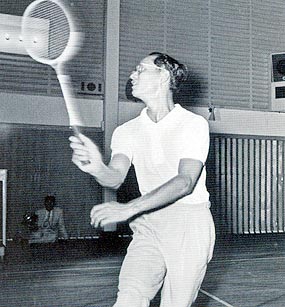
HM the King’s own example has always been a great source of inspiration to
athletes: every sailor knows that His Majesty is a Gold Medal helmsman,
winning the OK Dinghy Class in the South East Asian Peninsular Games on the
16th of December 1967, this day now celebrated as “National Sports Day” in
the Kingdom.
This nautical record is matched by a land-based one, HM the King being the
only person to have lit the torch, opening the quadrennial Asian Games on
four occasions, last time being in Bangkok in 1998, at the Rajamangala
Stadium, just one day after his Seventy-first birthday.
For example, when His Majesty the King trained a magnifying glass on the
torch to ignite the flame opening the Thirteenth Asian Games in December
1998, it was symbolic. The Monarch, an ardent supporter of all sports in the
Kingdom and elsewhere was, through that simple ritual, figuratively
conducting sunlight and the blessing it brings, onto the Games.
From another viewpoint, His Majesty’s care for the environment and the
natural state of the ecology as life support system for his subjects is also
well known. What better way to light the torch than using Nature’s own
power?
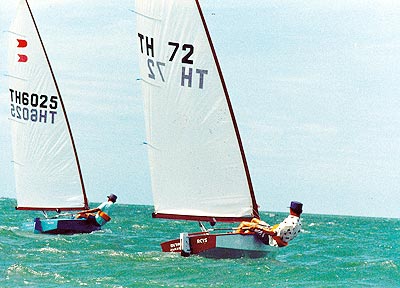
And what better sport for preserving Nature’s gifts than sailing? Forty
years ago this month, in fact, HM the King himself stood on the winner’s
podium as a Gold Medallist sailor in the Fourth South East Asian Peninsular
Games (changed in 1975 to the South East Asian Games when Indonesia and the
Philippines were admitted). On that occasion, HM the King came equal-first
with his eldest daughter HRH Ubolratana in the OK Dinghy Section of those
Games. It is a sporting record never likely to be equalled. HM the King has
been and inspiration to Thai athletes for four decades since then.
In fact, as is also well known, one of the best regattas in the region - if
not the world - is the Phuket King’s Cup Regatta, sailed to honour His
Majesty’s birthday every December since 1987. HM the King is the Royal
Patron of the regatta.
More appropriately, within the context of this story outlining HM the King’s
total support to Thai athletes and sports generally, no doubt, on the eve of
the recent 15th Asian
games in Doha, HM the King urged the huge Thai contingent of athletes “To
play all sports according to the rules,” show true spirit for victory and
friendship.
“If everybody does their best to win in both sports and friendship, the
country will benefit,” HM the King added. “A successful Asian Games would
show that the enthusiasm of Thai people had not been dulled during their
fight against the country’s dire economic crisis,” the Monarch observed. He
urged sportsmanship above all else: “Other competitors should not be
regarded as enemies, but rather as fellow competitors,” HM the King
concluded.
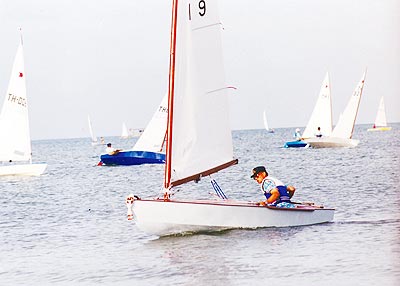
His Majesty is also well known as being highly-knowledgeable about many
sports having, at various times, participated himself in skiing, motor
racing, ice-skating, badminton, tennis, swimming and even a little golf.
As the then-president of the Thailand Olympic Committee, the late Air Chief
Marshal Dawee Chullasapya emphasized when presenting HM the King with the
highly-prestigious honour of “The Insignia of the Olympic Order” at
Rajanives Hall, Chitralada Palace, in December, 1987: “The King is not just
a world-class yachtsman, but he has also participated in - and encouraged -
many other sports.”
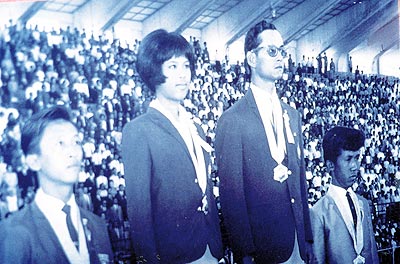
“The Olympic award was made not only to recognize HM the King’s prowess as a
dinghy sailor,” said ACM Dawee, “but also to acknowledge the leading role he
has played in promoting all sports - in Thailand, in the region and
internationally - always displaying a firm grasp on the history and the
finer points of a multitude of sports,” ACM Dawee added. His Majesty is the
only reigning Monarch to receive this accolade.
Another Olympic honour was bestowed upon His Majesty in 2001, when the
International Olympic Committee presented him with the IOC’s “Lalounis Cup”.
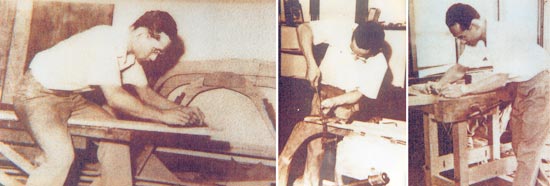
At work at Chitralada Villa, building one of his
dinghies
In boxing, too, HM the King has proven to be most knowledgeable. In 2001,
president of the World Boxing Council, Dr Jose Sulaiman, in bestowing upon
His Majesty the WBC’s “Golden Shining Symbol of World Leadership Award”, was
“amazed at HM the King’s knowledge of boxing”. Whereupon, HM the King urged
Dr Sulaiman “to promote boxing not only as a sport ... but also as an art of
self-defence.”
In Mexico, August 11, 2003, through the Royal Thai Embassy in Mexico City,
HM the King, in turn, bestowed the title of “Second Class Knight Commander
of the Most Admirable Order of the Direkgunabhorn” on Dr Sulaiman - one of
the highest Royal Awards ever to be conferred on a sports official.

Their Majesties the King and Queen attend
religious rites for the late
H.R.H. Princess Galyani Vadhana, at the Dusit Throne Hall inside the
Grand Palace Friday,
Nov. 14, 2008. (AP Photo/Bureau of the Royal Household)
A Royal loss
this year
It is with heavy hearts that the people of the Kingdom mourned with His
Majesty the King and the Royal Family when, in January this year, HRH
Princess Galyani Vadhana, the late beloved sister of HM the King died of
abdominal cancer at the age of 84.
In November this year, Their Majesties the King and Queen hosted the grand
six-day farewell funeral ceremony for the Beloved Princess. The Royal
Cremation started on November 14 when the His Majesty the King led the Royal
Family in a ceremony at the Grand Palace, beginning with religious rites for
HRH the late Princess at the Dusit Throne Hall inside the Grand Palace. His
Majesty King Bhumibol Adulyadej the Great lit joss sticks and candles as Her
Majesty Queen Sirikit looked on during the religious rites.
The grand cremation ceremony for HRH the Princess was held on Saturday, Nov.
15 at the Phra Maen Royal Ground in Bangkok. HM the King, accompanied by
Her Majesty the Queen, HRH Crown Prince Maha Vajiralongkorn, HRH Princess
Maha Chakri Sirindhorn, HRH Princess Chulabhorn, Her Royal Highness Srirasm,
Princess Sirivannavari, and members of the Royal Family attended.
In the morning, the body of HM the King’s sister was carried to a
seven-story pyre where she was cremated. His Majesty King Bhumibol
Adulyadej, the world’s longest-serving monarch, accompanied by Her Majesty
the Queen paid their last respects, then kindled a fire beneath the funeral
pyre after a day of Buddhist and Hindu rites for HRH the late Princess.
During the day, the royal cremation procession for the late Princess Galyani
Vadhana slowly moved past the Grand Palace towards the crematorium. The
Royal Great Victory Carriage carrying the urn and remains of HRH the
Princess was pulled by soldiers dressed in ancient uniforms.
A Brahmin priest helped elevate the urn of the late Princess Galyani Vadhana
on to the crematorium during the royal cremation rituals.
Tens of thousands of Thai people placed sandalwood flowers in front of a
photo of HRH Princess Galyani Vadhana at Sanam Luang near the royal palace,
as did millions of people throughout the Kingdom at their local temples,
during the funeral ceremony.
On November 18, Their Majesties the King and Queen, accompanied by HRH
Prince Maha Vajiralongkorn, HRH Princess Maha Chakri Sirindhorn, HRH
Princess Chulabhorn and Royal Family members traveled from Chitralada Palace
to attend a religious ceremony to make merit for the relics of HRH the late
Princess at the Dusit Throne Hall, Grand Palace. HRH Princess Ubolratana was
on hand to receive the Royal Family members upon arrival. Their Majesties
then paid respects to HRH the late Princess’s relics by performing religious
rites with offerings.
Epilogue
As one would expect from a Monarch defined as “Mahasammata”, or a “King of
Righteousness”, by all the people and who, upon his accession to the Throne
in 1950, embraced the “Tenfold Moral principles of the Sovereign”, His
Majesty has ruled quietly and without ostentation.
Starting very early in his reign and continuing to this day, HM the King,
usually accompanied by HM the Queen and second daughter HRH Princess Maha
Chakri Sirindhorn, travelled to the far corners of the Kingdom to learn
first-hand from the farmers and peoples of the rural areas about their
problems.
Again, as with all his other interests, the Monarch studies, observes,
photographs and imbues himself with all the relevant knowledge and facts
that he needs to move forward with recommendations, implementation of
beneficial projects and follow-up.
The Thai Monarch is probably best known, universally, for his unbending
resolve to improve the lives of each and every one of his people - a
singular dedication to their welfare which has been acclaimed from all
corners of the world.
A lasting image of HM the King is that of a man, often kneeling or sitting
on the ground, poring over charts and topographical maps of the area, while
surrounded by local farmers and villagers discussing their problems.
It has been recorded that HM the King has spent more than 200 days per year,
for more than three decades, in rural areas where he has initiated some
2,000 projects aimed solely at improving the well-being of his people.
Thus, through the illustrious decades of his rule, HM the King has been the
very embodiment of his “Oath of Accession” that “We will reign with
Righteousness for the Benefit and Happiness of the Siamese People.”
The world’s longest-reigning Monarch, this week celebrating his eighty-first
birthday, and now sixty-two years on the Thai Throne, continues to be, as he
has been for the six decades of his just reign, “The light of his land, the
pride of his people and a shining example to all peoples of a troubled
world.”
It was during a visit to New York, as a young King, accompanied by his
stunning bride, Queen Sirikit, that HM the King’s words were prophetic.
Addressing a committee of the Metropolitan Museum in 1967, HM the King said:
“Our world today is full of propaganda. Therefore, before we believe
anything, we should first look closely at the underlying reasons. The Lord
Buddha taught people to use their consciousness and intelligence to study,
seek and consider whether His teachings were the truth that is believable
rather than to believe (simply) because someone has enacted it.”
That was over forty years ago and, as we look around at the sorry state of
our contemporary world, HM the King’s words still ring true.
All of us at the Pattaya Mail, Pattaya Blatt, Pattaya Mail
on TV and Chiang Mai Mail extend our humblest wishes for a most
happy 81st birthday.
